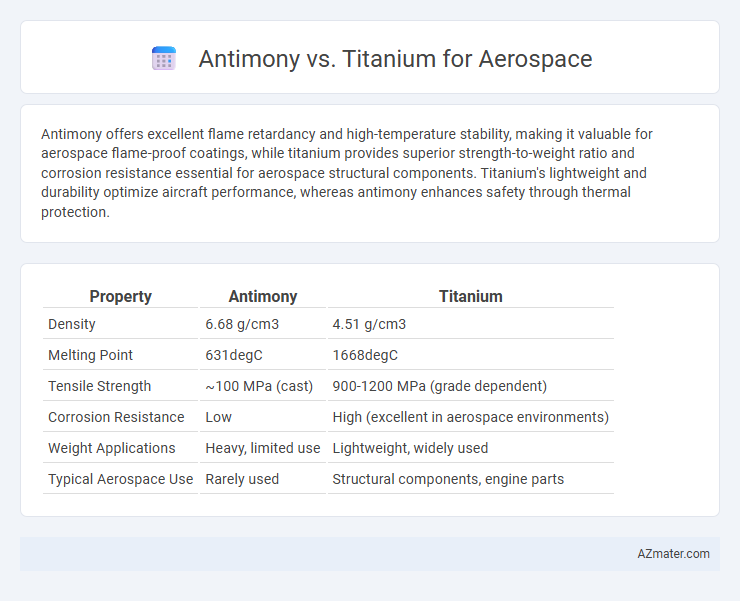Antimony offers excellent flame retardancy and high-temperature stability, making it valuable for aerospace flame-proof coatings, while titanium provides superior strength-to-weight ratio and corrosion resistance essential for aerospace structural components. Titanium's lightweight and durability optimize aircraft performance, whereas antimony enhances safety through thermal protection.
Table of Comparison
| Property | Antimony | Titanium |
|---|---|---|
| Density | 6.68 g/cm3 | 4.51 g/cm3 |
| Melting Point | 631degC | 1668degC |
| Tensile Strength | ~100 MPa (cast) | 900-1200 MPa (grade dependent) |
| Corrosion Resistance | Low | High (excellent in aerospace environments) |
| Weight Applications | Heavy, limited use | Lightweight, widely used |
| Typical Aerospace Use | Rarely used | Structural components, engine parts |
Introduction to Antimony and Titanium in Aerospace
Antimony is primarily used in aerospace for its flame-retardant properties and as an alloying element to improve the mechanical strength and corrosion resistance of metals. Titanium, prized for its exceptional strength-to-weight ratio and high resistance to heat and corrosion, is extensively utilized in aerospace components such as airframe structures and engine parts. Both elements play critical roles in enhancing the durability, safety, and performance of aerospace materials.
Material Properties Comparison
Antimony exhibits high density and excellent thermal stability but lacks the tensile strength and corrosion resistance required for aerospace applications compared to titanium. Titanium provides superior strength-to-weight ratio, exceptional corrosion resistance, and excellent fatigue performance, making it ideal for aircraft structural components and engine parts. The lightweight nature and biocompatibility of titanium further enhance its preference over antimony in aerospace material selection.
Structural Strength and Durability
Titanium exhibits superior structural strength and durability compared to antimony, making it the preferred choice in aerospace applications. Titanium's high strength-to-weight ratio and excellent corrosion resistance enhance aircraft performance and longevity under extreme conditions. Antimony, primarily used as an alloying element or flame retardant, lacks the mechanical properties required for critical structural components in aerospace engineering.
Corrosion Resistance Performance
Antimony enhances corrosion resistance by forming protective oxide layers that prevent metal degradation, making it valuable for aerospace alloys exposed to harsh environments. Titanium exhibits superior corrosion resistance due to its spontaneous passivation, maintaining structural integrity under extreme conditions and in saltwater or chemical exposures common in aerospace applications. The combination or selective use of antimony and titanium alloys can optimize corrosion resistance performance, ensuring longer lifespan and safety for aerospace components.
Weight Considerations and Density
Antimony exhibits a high density of approximately 6.7 g/cm3, making it less suitable for aerospace applications where weight reduction is critical. Titanium, with a density of about 4.5 g/cm3, provides an excellent strength-to-weight ratio essential for aerospace components, balancing durability and lightweight performance. Weight considerations in aerospace engineering often favor titanium due to its superior density characteristics and mechanical properties compared to antimony.
Thermal Stability and Performance
Antimony exhibits lower thermal stability compared to titanium, limiting its use in high-temperature aerospace applications where titanium's melting point of 1,668degC and exceptional strength-to-weight ratio provide superior performance. Titanium alloys maintain structural integrity and corrosion resistance under extreme thermal cycles, making them ideal for engine components and airframe parts exposed to fluctuating temperatures. The superior thermal conductivity and oxidation resistance of titanium enhance durability and efficiency in aerospace environments where antimony's brittleness and lower melting point restrict its functional roles.
Machinability and Fabrication Processes
Antimony is rarely used in aerospace applications due to limited machinability and complex fabrication processes, whereas titanium is highly favored for its excellent machinability combined with superior strength-to-weight ratio. Titanium alloys enable precise machining and advanced fabrication techniques such as additive manufacturing and superplastic forming, which enhance component performance and durability. The choice of titanium significantly reduces production challenges while improving structural integrity compared to the brittle and less versatile antimony.
Cost and Availability in Aerospace Applications
Antimony is rarely used in aerospace applications due to its limited availability and high extraction costs, making it less economical compared to titanium. Titanium offers superior cost-effectiveness through widespread availability and efficient manufacturing processes, supporting large-scale aerospace production. The metal's abundance and recyclability further reduce long-term expenses, solidifying titanium as the preferred material over antimony for aerospace cost optimization.
Safety and Environmental Factors
Titanium's high strength-to-weight ratio and corrosion resistance make it a preferred aerospace material, enhancing structural safety and durability while reducing environmental impact through long lifecycle and recyclability. Antimony, primarily used as a flame retardant additive in aerospace composites, contributes to fire safety but poses environmental concerns due to its toxicity and persistence in ecosystems. Selecting titanium supports sustainable aerospace applications by minimizing hazardous emissions and promoting safer, more environmentally friendly aircraft components.
Future Trends in Aerospace Material Selection
Future trends in aerospace material selection emphasize the critical roles of titanium and antimony, where titanium's superior strength-to-weight ratio and corrosion resistance drive its extensive use in airframe and engine components. Emerging research highlights antimony's potential in enhancing composite materials' fire resistance and thermal stability, contributing to safer, lighter aerospace structures. Advances in nanotechnology and material science are expected to optimize titanium-antimony alloys and composites, promoting improved durability, fuel efficiency, and sustainability in next-generation aerospace designs.

Infographic: Antimony vs Titanium for Aerospace
 azmater.com
azmater.com